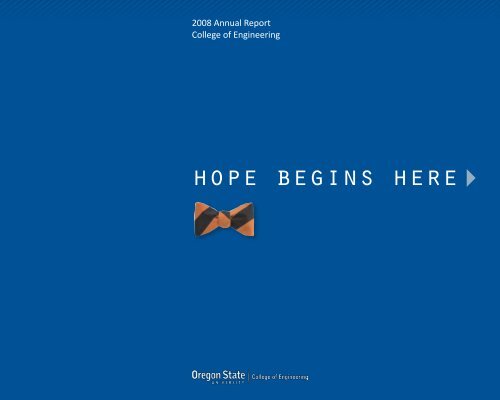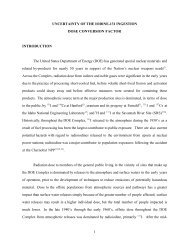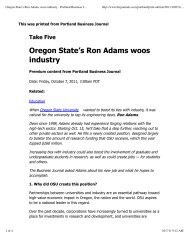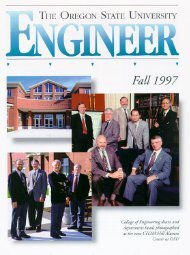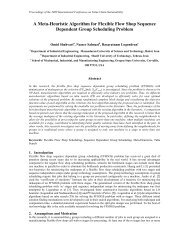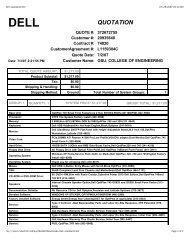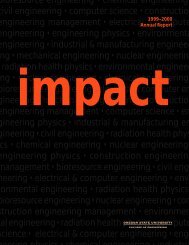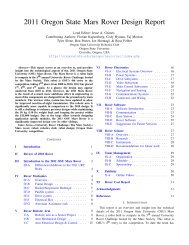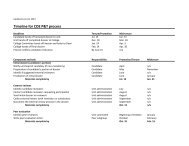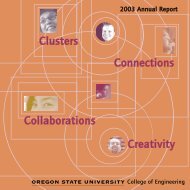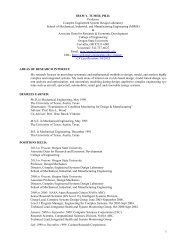hope begins here - College of Engineering - Oregon State University
hope begins here - College of Engineering - Oregon State University
hope begins here - College of Engineering - Oregon State University
You also want an ePaper? Increase the reach of your titles
YUMPU automatically turns print PDFs into web optimized ePapers that Google loves.
2008 Annual Report<br />
<strong>College</strong> <strong>of</strong> <strong>Engineering</strong><br />
<strong>hope</strong> <strong>begins</strong> <strong>here</strong><br />
1
The Vision<br />
Collaborative innovation is<br />
pervasive in the OSU <strong>College</strong> <strong>of</strong><br />
<strong>Engineering</strong>. Student teams thrive<br />
in our culture, and they <strong>of</strong>ten bring<br />
home trophies. Creative energy<br />
crosses disciplines as the greatest<br />
minds in the nation unite to take on<br />
some <strong>of</strong> society’s biggest challenges:<br />
today we are poised for tremendous<br />
impact on multiple aspects <strong>of</strong> energy<br />
independence and engineered<br />
sustainability.<br />
Collaborative innovation happens<br />
easily <strong>here</strong>, but not without the<br />
influence <strong>of</strong> leadership. Leadership<br />
provided when a special person<br />
comes along with an idea and a<br />
vision, a person who just seems to<br />
stand out above the rest. Someone<br />
who sees what could be and devotes<br />
the energy, the <strong>hope</strong>, the enthusiasm<br />
and the leadership it takes to create<br />
a new and better future. Martin<br />
Kelley was such a person.<br />
As much as we believe in the<br />
power <strong>of</strong> collaborative innovation<br />
to develop great engineers and<br />
solve big problems, sometimes we<br />
also need to stop and recognize<br />
the leaders who can make such a<br />
pr<strong>of</strong>ound difference in our colleges,<br />
our universities and our nation. In<br />
this report, you’ll read more about<br />
Martin and the impact his vision and<br />
leadership have had on the <strong>College</strong><br />
<strong>of</strong> <strong>Engineering</strong>. Martin passed away<br />
last summer, but he will always hold<br />
a special place in our hearts.<br />
Martin’s historic gift <strong>of</strong> $20 million<br />
in 2000 was a tipping point in the<br />
history <strong>of</strong> our college. It wasn’t just<br />
the money. It was his vision <strong>of</strong> what<br />
could be and his energy in helping<br />
to bring others on board, to instill<br />
the belief that we really will deliver<br />
the impact <strong>of</strong> one <strong>of</strong> the nation’s top<br />
engineering programs. That donation<br />
has already helped to stimulate<br />
another $100 million in private gifts<br />
and led to many amazing results.<br />
Our faculty has created significant<br />
research programs, including the<br />
National Tsunami Wave Basin,<br />
the <strong>Oregon</strong> Nanoscience and<br />
Microtechnologies Institute and<br />
the Northwest National Marine<br />
Renewable Energy Center. They’ve<br />
launched 11 new companies based<br />
on their research results, and those<br />
companies have already attracted<br />
another $85 million in private<br />
investments.<br />
<strong>College</strong> <strong>of</strong> <strong>Engineering</strong> research<br />
on aging bridge structures helped<br />
save <strong>Oregon</strong>ians $500 million in<br />
bridge repair work — and what<br />
we’ve learned will aid crumbling<br />
infrastructures all over the nation.<br />
The total renovation <strong>of</strong> Apperson<br />
Hall — soon to become Kearney<br />
Hall — is nearing completion. The<br />
number <strong>of</strong> top high school graduates<br />
entering the college has nearly<br />
tripled since Martin’s gift. Our<br />
students are winning national design<br />
competitions, such as the first-place<br />
entry in the 2008 Mars Rover event.<br />
The drive is gaining speed.<br />
As you read this report, you’ll<br />
find many examples <strong>of</strong> advanced<br />
engineering research at OSU. Our<br />
progress and building momentum<br />
are a tribute to a great engineer and<br />
a man with vision. A man who, like<br />
many <strong>of</strong> us, was proud to call himself<br />
an alumnus <strong>of</strong> the OSU <strong>College</strong> <strong>of</strong><br />
<strong>Engineering</strong>.<br />
Ron Adams, Dean<br />
Dean Ron Adams demonstrates<br />
the dancing robotic beaver, one <strong>of</strong><br />
many TekBots designed and built by<br />
<strong>College</strong> <strong>of</strong> <strong>Engineering</strong> students.
Martin<br />
moments<br />
In 2003, when work<br />
began on the building<br />
that would bear his name,<br />
Martin Kelley treated it<br />
like any other construction<br />
project. Every three months,<br />
he toured the site, met<br />
with project engineers and<br />
received budget updates.<br />
“For a while, I was afraid we might<br />
have the largest swimming pool<br />
in <strong>Oregon</strong>,” he joked with guests<br />
at the Kelley <strong>Engineering</strong> Center<br />
grand opening in 2005. “But to say<br />
that I am pleased with the results<br />
would be a huge understatement.”<br />
He had no idea, he added, when he<br />
agreed in 2000 to contribute $20<br />
million to the project, that it would<br />
“be this nice <strong>of</strong> an institution for<br />
group learning.”<br />
Gift sparks additional<br />
investments<br />
Kelley may not have anticipated<br />
something else: the enthusiasm<br />
and sense <strong>of</strong> <strong>hope</strong> he sparked<br />
among other <strong>College</strong> <strong>of</strong> <strong>Engineering</strong><br />
alumni. His vision and philanthropic<br />
leadership became the tipping point<br />
in the college’s success with the<br />
center and the Campaign for OSU –<br />
leading to more than $100 million in<br />
private investments.<br />
Those funds have led to new student<br />
scholarships, faculty endowments<br />
and additional facility improvements,<br />
stemming from the pride and<br />
generosity spurred by Kelley’s<br />
landmark gift.<br />
Five things<br />
stand out about<br />
Martin Kelley,<br />
according to<br />
OSU Foundation<br />
Board chair<br />
Darald W.<br />
Callahan:<br />
“his dedicated<br />
leadership,<br />
incredible<br />
generosity,<br />
humility, great<br />
stories and<br />
sense <strong>of</strong> humor<br />
and <strong>of</strong> course,<br />
that trademark<br />
bow tie.”<br />
The 2008 Annual Report is dedicated to<br />
Martin Kelley (1928-2008), known for his<br />
trademark bow tie and generosity to OSU<br />
— including the $20 million lead gift to<br />
“His vision and philanthropic leadership became the tipping point in the college’s success…”<br />
build the Kelley <strong>Engineering</strong> Center.<br />
2 3<br />
— Ron Adams
“His trademark bow tie is<br />
a clue that he would have<br />
had a successful career as<br />
a university pr<strong>of</strong>essor.”<br />
— Lee Kearney<br />
“He launched the<br />
transformation <strong>of</strong> the<br />
<strong>College</strong> <strong>of</strong> <strong>Engineering</strong>.”<br />
— Ron Adams<br />
Martin<br />
moments<br />
Martin grew up<br />
in Pasadena,<br />
Calif., in a family<br />
that stressed<br />
responsibility,<br />
independence<br />
and a strong<br />
work ethic. This<br />
emphasis on<br />
independence<br />
was one reason<br />
he came to<br />
<strong>Oregon</strong> <strong>State</strong> in<br />
1945 to study<br />
civil engineering.<br />
The “gospel <strong>of</strong> sound<br />
practices”<br />
It may not have been a surprise<br />
to anyone who knew him well.<br />
Rigorous education and training<br />
are keystones, Kelley believed,<br />
to keeping the public trust in<br />
engineering. He loved to mentor<br />
young engineers, and his direct,<br />
easygoing manner, integrity and<br />
commitment to principles made<br />
a lasting impression on them,<br />
according to Lee Kearney, former<br />
colleague and 1963 OSU civil<br />
engineering alum. “He preached<br />
regularly the gospel <strong>of</strong> sound<br />
estimating and engineering<br />
practices. His trademark bow tie is<br />
a clue that he would have had a<br />
successful career as a university<br />
pr<strong>of</strong>essor,” Kearney added.<br />
An accomplished career<br />
After graduating from OSU with<br />
a degree in civil engineering in<br />
1950, Kelley played key roles in<br />
some <strong>of</strong> the world’s most ambitious<br />
construction projects: Quebec’s<br />
James Bay hydropower dams, the<br />
San Francisco Trans-Bay Tube, the<br />
Danish Great Belt Crossing and New<br />
York City’s 63rd Street Tube and<br />
Tunnel Project. Today, millions rely<br />
on his accomplishments in energy<br />
and transportation systems that<br />
light homes, run factories and speed<br />
daily commutes.<br />
Originally anonymous<br />
Kelley retired in 1990 as the vice<br />
president and chief engineer at<br />
the Kiewit Company, one <strong>of</strong> the<br />
nation’s largest construction firms.<br />
His commitment to education<br />
led him to serve with the <strong>Oregon</strong><br />
<strong>State</strong> <strong>University</strong> Foundation Board<br />
<strong>of</strong> Trustees and the <strong>College</strong> <strong>of</strong><br />
<strong>Engineering</strong> Advisory Board.<br />
After meeting with Ron Adams,<br />
who became dean <strong>of</strong> the <strong>College</strong> <strong>of</strong><br />
<strong>Engineering</strong> in 1998, Kelley decided<br />
to launch a renaissance at his alma<br />
mater. “Ron talked about what<br />
he thinks makes things work and<br />
move is people, pr<strong>of</strong>essors and more<br />
students. I agreed with him, but I<br />
said if you’re going to have more<br />
pr<strong>of</strong>essors and people, you’ll need a<br />
place to put them,” Kelley said.<br />
Former OSU president Paul Risser<br />
remembers how Kelley arrived at<br />
the decision to jump-start a new<br />
building. “He and I had several<br />
discussions about the importance <strong>of</strong><br />
engineering, especially in <strong>Oregon</strong>,”<br />
Risser said. “When Martin came to<br />
me to say that he wanted to make<br />
a large gift for the engineering<br />
building, he said it was to be totally<br />
anonymous. In fact, he told me<br />
that if it became known he was the<br />
donor, he would take back the gift.<br />
This was his humbleness.”<br />
A legacy <strong>of</strong> leadership<br />
“The Kelley <strong>Engineering</strong> Center says<br />
to <strong>Oregon</strong> and the nation that OSU is<br />
serious about its mission. It signals<br />
that our aspirations are high and<br />
realistic. Above all else, it announces<br />
loud and clear that OSU is supported<br />
by individuals <strong>of</strong> vision and<br />
determination who care pr<strong>of</strong>oundly<br />
about this nation and this state,”<br />
OSU President Ed Ray said at the<br />
grand opening.<br />
Kelley earned OSU’s highest awards<br />
for his leadership. Among them were<br />
the Lifetime Trustee Award from the<br />
OSU Foundation and the E.B. Lemon<br />
Distinguished Alumni Award from<br />
the OSU Alumni Association.<br />
“I witnessed the sense <strong>of</strong> pride<br />
that he had as he walked through<br />
the building the first time,” says<br />
Terri Fiez, head <strong>of</strong> the School <strong>of</strong><br />
Electrical <strong>Engineering</strong> and Computer<br />
Science. “Last year, he came to the<br />
engineering orientation and brought<br />
some friends to see the building.<br />
He then went out to the ice cream<br />
social with all the new freshmen and<br />
got his picture taken with students.<br />
Again, very proud!”<br />
His contribution was nothing less<br />
than monumental, says Ron Adams.<br />
“He launched the transformation <strong>of</strong><br />
the <strong>College</strong> <strong>of</strong> <strong>Engineering</strong>.”<br />
4<br />
5
Apperson to Kearney<br />
Lee and Connie Kearney<br />
provided the lead gift for<br />
the renovation <strong>of</strong> historic<br />
Apperson Hall.<br />
More than 40 years ago, Lee<br />
Kearney (’63) took classes like<br />
dynamics and fluid mechanics in<br />
Apperson Hall. Back then, the woodframe<br />
building was much like it<br />
was before renovations started last<br />
year, with creaky steps and support<br />
columns in the middle <strong>of</strong> classrooms,<br />
blocking students’ views.<br />
In a few months, the cornerstone <strong>of</strong><br />
<strong>Engineering</strong> Row will emerge with a<br />
new steel structure behind its historic<br />
stone façade. And it will have a new<br />
name: Kearney Hall, in recognition<br />
<strong>of</strong> Lee and Connie Kearney’s lead gift<br />
<strong>of</strong> $4 million toward the $12 million<br />
renovation project.<br />
W<strong>here</strong> the<br />
past and<br />
future meet<br />
Part <strong>of</strong> a strategic plan<br />
A longtime member <strong>of</strong> the <strong>College</strong> <strong>of</strong><br />
<strong>Engineering</strong>’s Advisory Board, Kearney<br />
knew better facilities — in addition<br />
to scholarships, faculty and research<br />
grants — were needed to move the<br />
program forward. Renovating the<br />
100+ year-old Apperson Hall was<br />
part <strong>of</strong> the strategic plan adopted by<br />
the board, Dean Ron Adams and the<br />
department heads.<br />
“We needed to expand our capacity<br />
to produce more graduate engineers,<br />
which are definitely in short supply<br />
in <strong>Oregon</strong> and all over the nation,”<br />
Kearney says. “This project matched<br />
my interest, and I felt it would<br />
allow the continuation <strong>of</strong> our overall<br />
improvement program.”<br />
A collaborative environment<br />
Like the Kelley <strong>Engineering</strong> Center,<br />
the new Kearney Hall will create an<br />
environment for collaboration, with<br />
multiple engineering disciplines<br />
under one ro<strong>of</strong>. Kearney believes this<br />
“collegial atmosp<strong>here</strong>” has helped<br />
the <strong>College</strong> <strong>of</strong> <strong>Engineering</strong> recruit<br />
more top faculty. “When they see<br />
how this group works together,<br />
that’s the deciding factor that makes<br />
it easy for them to come to <strong>Oregon</strong><br />
<strong>State</strong>,” Kearney says.<br />
The nearly total reconstruction<br />
<strong>of</strong> the building — with the steel<br />
structure, those view-blocking<br />
columns are gone — includes<br />
interactive classrooms and a<br />
computerized learning laboratory,<br />
along with space w<strong>here</strong> students and<br />
faculty can collaborate on projects.<br />
“It’s a huge improvement over what<br />
was t<strong>here</strong>,” Kearney says. Bringing a<br />
21st-century learning environment<br />
to one <strong>of</strong> the oldest buildings on<br />
campus is a “nice compromise”<br />
between the past and the future.<br />
The new Kearney Hall<br />
incorporates an entirely new<br />
steel structure and interior<br />
6<br />
behind its historic stone façade.<br />
7
OSU is a national and<br />
international leader in<br />
That research is also<br />
diverse, exploring<br />
multiple pathways to<br />
energy independence. From<br />
harnessing the wind and<br />
waves to highly efficient<br />
solar cells and biodiesel<br />
production, safe nuclear<br />
reactors and hydrogen<br />
fuel cells, OSU researchers<br />
and industry partners are<br />
finding new ways to power<br />
the global economy.<br />
Innovative,<br />
renewable and<br />
sustainable<br />
energy research<br />
Ocean Energy – <strong>Oregon</strong><br />
has become a national and<br />
international leader in the<br />
development <strong>of</strong> wave energy,<br />
the result <strong>of</strong> pioneering<br />
work under lead collaborator<br />
Annette von Jouanne, a<br />
pr<strong>of</strong>essor <strong>of</strong> electrical<br />
engineering. OSU is now home<br />
to the Northwest National<br />
Marine Energy Center, which is<br />
working to make wave energy<br />
production a reality. This<br />
is a vast, largely untapped<br />
energy source that’s clean,<br />
environmentally benign, costeffective<br />
and perpetual.<br />
Biodiesel – Goran Jovanovic,<br />
a pr<strong>of</strong>essor <strong>of</strong> chemical<br />
engineering, is the lead<br />
collaborator on developing<br />
a working prototype <strong>of</strong> a<br />
tiny chemical reactor for<br />
manufacturing biodiesel –<br />
one that is efficient, fast<br />
and portable.<br />
Solar – It wasn’t even<br />
considered at first as one <strong>of</strong><br />
the likely uses, but <strong>College</strong> <strong>of</strong><br />
<strong>Engineering</strong> breakthroughs<br />
in transparent electronics<br />
may find some <strong>of</strong> their first<br />
applications in new solar<br />
energy devices that are up to<br />
four times more cost-efficient<br />
than existing approaches.<br />
Hydrogen – Hong Liu,<br />
an assistant pr<strong>of</strong>essor <strong>of</strong><br />
biological engineering, has<br />
created ways to produce both<br />
electricity and hydrogen gas<br />
from sewage in systems that<br />
may significantly bring down<br />
the cost <strong>of</strong> hydrogen for use<br />
in fuel cells – <strong>of</strong>ten seen as<br />
the fuel for automobiles <strong>of</strong> the<br />
future. And the technology<br />
cleans the water at the same<br />
time.<br />
Wind – OSU was an early<br />
leader in wind energy research<br />
and specializes in assessing<br />
the wind-power potential for<br />
private and public landowners.<br />
Many <strong>of</strong> OSU’s energy research<br />
initiatives are coordinated<br />
through the <strong>Oregon</strong> Built<br />
Environment and Sustainable<br />
Technologies (<strong>Oregon</strong> BEST)<br />
signature research cluster.<br />
Among its goals, <strong>Oregon</strong> BEST<br />
aims to make the state a leader<br />
in clean energy, bio-based<br />
products and green buildings.<br />
“T<strong>here</strong>’s a<br />
culture<br />
shift going<br />
on at OSU.”<br />
Over the past five years, <strong>College</strong> <strong>of</strong> <strong>Engineering</strong> research has spun out 11 new companies and attracted more than $85<br />
million in private investments. Joe Tanous joined the college two years ago to help commercialize OSU innovations.<br />
The strong research programs in<br />
the OSU <strong>College</strong> <strong>of</strong> <strong>Engineering</strong><br />
are increasingly going to work —<br />
creating new products, establishing<br />
new companies and attracting new<br />
investments.<br />
“T<strong>here</strong>’s a culture shift going on<br />
at OSU,” says Joe Tanous, who was<br />
brought to the college two years ago<br />
to serve as innovation liaison. “We’ve<br />
had some great research programs<br />
and accomplishments <strong>here</strong> for a long<br />
time, but too <strong>of</strong>ten they just ended<br />
up on the shelf.”<br />
“We’re not going to let them fall<br />
into that black hole any more,”<br />
he says. “We’re going to get them<br />
commercialized. It’s good for the<br />
faculty, for the students, for the<br />
university and for the public.”<br />
Various tools are available now<br />
to help with the task, Tanous<br />
says, including venture grants,<br />
the facilities <strong>of</strong> ONAMI and other<br />
initiatives designed to get new<br />
findings out <strong>of</strong> the laboratory and<br />
into the commercial marketplace.<br />
The results are starting to show:<br />
Strands is all about “discovery,”<br />
according to OSU computer<br />
scientist Jon Herlocker, who<br />
helped found the company<br />
in 2004. Strands has created<br />
a social recommender engine<br />
that is able to provide real-time<br />
recommendations <strong>of</strong> products<br />
and services through computers,<br />
mobile phones and other Internetconnected<br />
devices.<br />
RedRover S<strong>of</strong>tware, a startup<br />
built on 10 years <strong>of</strong> research by<br />
OSU computer scientists including<br />
Margaret Burnett and Martin<br />
Erwig, provides pioneering new<br />
tools to detect and fix errors in<br />
computer spreadsheets, an issue<br />
that costs billions for companies<br />
around the world.<br />
MTek Energy Solutions is<br />
creating a credit-card sized biodiesel<br />
device that combines vegetable<br />
oil, alcohol and a catalyst in tiny<br />
microreactors to produce biodiesel<br />
fuel. The company is a spinout from<br />
OSU’s leadership in microreactor<br />
technology and original research<br />
by OSU chemical engineer Goran<br />
Jovanovic.<br />
Nanobits is another spinout<br />
from OSU microreactor technology<br />
research. The company is creating<br />
new devices for use in specialty<br />
chemical and nanomaterial<br />
manufacturing. Alex Chang, an<br />
associate pr<strong>of</strong>essor <strong>of</strong> chemical<br />
engineering, is developing<br />
microreactor technology to produce<br />
nanoparticles for drug delivery.<br />
Martin<br />
moments<br />
Martin was a<br />
consummate<br />
teacher and<br />
coach; his<br />
colleagues<br />
thought he<br />
would have<br />
made an<br />
excellent college<br />
pr<strong>of</strong>essor had<br />
he not gone into<br />
engineering and<br />
construction.<br />
8<br />
9
Jose Reyes has led breakthrough<br />
research into small-scale nuclear<br />
power plants that incorporate passivesafety<br />
design features.<br />
Converting economy <strong>of</strong> scale<br />
into the economy <strong>of</strong> small<br />
Martin<br />
moments<br />
Martin believed<br />
he graduated<br />
with a solid<br />
grounding in<br />
the practical<br />
applications <strong>of</strong><br />
engineering.<br />
“I always felt<br />
<strong>Oregon</strong> <strong>State</strong><br />
did a good job<br />
<strong>of</strong> preparing me<br />
for my career in<br />
civil engineering<br />
construction,”<br />
he said.<br />
“We wanted<br />
something small,<br />
really small, and<br />
really safe.”<br />
—Jose Reyes<br />
When Jose Reyes was considering<br />
different types <strong>of</strong> nuclear reactor<br />
designs in the late 1990s, practically<br />
all commercial power reactors were<br />
big. Really big. They embraced the<br />
concept <strong>of</strong> “economy <strong>of</strong> scale,” in<br />
which large reactors that produced<br />
more electricity were the most costeffective.<br />
Reyes had a different vision: the<br />
economy <strong>of</strong> small. So small, in<br />
fact, that a reactor could be built<br />
in a factory, mass produced with<br />
tight quality control and shipped<br />
easily to w<strong>here</strong>ver it was needed.<br />
And that vision ultimately became<br />
the foundation <strong>of</strong> NuScale Power, a<br />
startup firm that is already being<br />
called a “company to watch” by the<br />
Forbes/Wolfe Emerging Tech Report.<br />
“At first, we were thinking primarily<br />
<strong>of</strong> designs that could bring the<br />
benefits <strong>of</strong> nuclear power to remote<br />
locations or developing countries,”<br />
says Reyes, pr<strong>of</strong>essor and head<br />
<strong>of</strong> OSU’s Department <strong>of</strong> Nuclear<br />
<strong>Engineering</strong> and Radiation Health<br />
Physics.<br />
Really small – and really safe<br />
“We wanted something small,<br />
really small, and really safe,” he<br />
says. “Then we had 9-11, and we<br />
realized these same designs could<br />
also be extremely low pr<strong>of</strong>ile,<br />
placed underground and much less<br />
vulnerable to terrorist attack, even<br />
addressing nuclear proliferation<br />
concerns. All the pieces seemed to<br />
come together.”<br />
The idea <strong>of</strong> extremely small nuclear<br />
reactors that could fit on a truck<br />
or railroad car – incorporating the<br />
latest passive safety concepts that<br />
OSU helped pioneer during the<br />
1990s – is now moving closer to a<br />
commercial reality.<br />
The plan is small, modular nuclear<br />
reactor cores that would produce<br />
45 megawatts <strong>of</strong> power each –<br />
enough for about 45,000 homes –<br />
which could be grouped to provide<br />
whatever amount <strong>of</strong> power is needed.<br />
They could be installed incrementally<br />
to minimize up-front investment<br />
costs, speed the completion <strong>of</strong> new<br />
energy facilities and produce large<br />
amounts <strong>of</strong> electricity with no<br />
greenhouse gas emissions.<br />
“We’re creating a design that will<br />
answer many <strong>of</strong> the real obstacles<br />
faced in the construction <strong>of</strong> new<br />
nuclear plants, whether they<br />
relate to safety, cost or ease <strong>of</strong><br />
construction,” says Reyes, who<br />
is also the chief technical <strong>of</strong>ficer<br />
<strong>of</strong> NuScale. “These reactors will<br />
contribute to the renaissance <strong>of</strong><br />
nuclear energy all over the world.”<br />
OSU innovation, plus industry<br />
support<br />
This work started as a collaboration<br />
between OSU, Idaho National<br />
Laboratory and Nexant/Bechtel, with<br />
support in the early 2000s by the<br />
U.S. Department <strong>of</strong> Energy. With a<br />
partnership now in place with Kiewit<br />
Construction, a major power plant<br />
constructor, NuScale Power plans<br />
to take the approach to a working<br />
reality. OSU has three patents on<br />
the technology, and the university<br />
will help test the design. Final<br />
certification may be possible within<br />
five years.<br />
“Cost is important, but safety<br />
in every sense is the real key to<br />
modular reactors,” says Reyes. “This<br />
is a post 9-11 design in which the<br />
reactor core will sit underground<br />
inside a concrete container, with<br />
resistance to air attack by terrorists<br />
one <strong>of</strong> the considerations. All things<br />
considered, it should be the safest<br />
light water reactor ever built.”<br />
“The progress we’ve already made<br />
has been enormous,” he says. “The<br />
future looks bright.”<br />
10<br />
11
The<br />
Diatomic<br />
Trio<br />
Earning three degrees – with a little help from his friends<br />
It’s been a long journey<br />
for Clayton Jeffries. He<br />
went from years <strong>of</strong> work<br />
as a carpet cleaner for his<br />
dad’s business in Bend to<br />
earning three OSU degrees<br />
– a bachelor’s, master’s and<br />
soon a doctorate in chemical<br />
engineering – while helping<br />
to create breakthroughs in<br />
using diatoms, a single-celled<br />
marine life form, in devices<br />
with electronic or biological<br />
applications.<br />
But he wouldn’t have gotten t<strong>here</strong><br />
without a little help from his friends<br />
– the pr<strong>of</strong>essors who believed in his<br />
talents, fellow students who shared<br />
their knowledge and even younger<br />
students whom he now tries to help<br />
as a mentor in his own right.<br />
“We all pull each other up.”<br />
“Guidance and mentoring are just<br />
so important,” says Jeffries, who<br />
always liked science, but didn’t<br />
even start college until five years<br />
after graduating from Redmond<br />
High School. “Your pr<strong>of</strong>essors help<br />
lay out goals, you work closely with<br />
your fellow students, and when you<br />
get far enough along, you try to<br />
give back, help younger students.<br />
We all pull each other up.”<br />
Greg Rorrer, a pr<strong>of</strong>essor <strong>of</strong><br />
chemical engineering, echoes those<br />
sentiments.<br />
“We create the concepts, help guide<br />
our students and get the funding,<br />
but we’d be now<strong>here</strong> without the<br />
talents <strong>of</strong> people like Clayton,”<br />
Rorrer says. “They have a strong<br />
work ethic, youthful energy and the<br />
ability to work with and learn from<br />
their pr<strong>of</strong>essors and peers. This is<br />
really no place for a loner.”<br />
Rorrer and associate pr<strong>of</strong>essor<br />
Alex Chang are making exciting<br />
advances in the use <strong>of</strong> diatoms,<br />
marine life forms that might<br />
be biologically fabricated into<br />
solar cells to produce electricity.<br />
They show promise as unique<br />
biological sensors to detect immune<br />
disease. And their shells have been<br />
incorporated into microelectronic<br />
devices to manipulate broadspectrum<br />
light. With support <strong>of</strong><br />
a $1.3 million grant from the<br />
National Science Foundation, their<br />
research on diatoms has produced 11<br />
publications – just in the past year.<br />
“We need to scale up these systems<br />
to larger applications and test their<br />
reliability,” Chang says. “But some<br />
projects, especially the biological<br />
sensors, are getting pretty close.<br />
And we wouldn’t be making these<br />
advances without all <strong>of</strong> our students,<br />
who have such a passion for their<br />
work.”<br />
Jeffries says he may move eventually<br />
to the private sector or agency<br />
research.<br />
“This bridge between biology and<br />
material science is very interesting,<br />
and t<strong>here</strong>’s still so much we need to<br />
learn,” Jeffries says. “I may go into<br />
private research, but I don’t ever<br />
want to leave behind the type <strong>of</strong><br />
mentoring that exists at OSU. I want<br />
to keep doing that.”<br />
Martin<br />
moments<br />
Martin <strong>of</strong>ten<br />
mentioned his<br />
“bottleneck<br />
theory <strong>of</strong><br />
management:<br />
when t<strong>here</strong> are<br />
problems in an<br />
organization,<br />
the bottleneck<br />
will be found at<br />
the top.”<br />
Ph.D. student Clayton Jefferies (center), together<br />
with his pr<strong>of</strong>essors, Greg Rorrer (left) and Alex<br />
Chang (right), are finding how diatoms — singlecell<br />
marine life forms — might be biologically<br />
fabricated into solar cells to produce electricity.<br />
12<br />
13
Kate Hunter-<br />
Zaworski<br />
opens the<br />
world to<br />
people with<br />
disabilities.<br />
Iused to backpack in the Mt.<br />
Jefferson Wilderness,” reminisces<br />
Marlene Massey <strong>of</strong> Corvallis. “Now,<br />
it’s a challenge just to cross the<br />
street.” Since the results <strong>of</strong> brain<br />
surgery left her in a wheelchair 12<br />
years ago, Massey has depended on<br />
transportation services that can<br />
safely accommodate her Breezy 600.<br />
“<br />
Making it easier for people like<br />
Massey to get around is the mission<br />
<strong>of</strong> OSU’s National Center for<br />
Accessible Transportation (NCAT),<br />
funded by the U.S. Department <strong>of</strong><br />
Education. Under the leadership <strong>of</strong><br />
engineer Katharine Hunter-Zaworski,<br />
experts in biomechanics, ergonomics<br />
and mechanical engineering design<br />
equipment for mass transit systems<br />
— everything from bus lifts to<br />
boarding ramps and a wheelchairaccessible<br />
lavatory in the new Boeing<br />
787 Dreamliner.<br />
For people whose mobility is limited<br />
by physical, sensory or cognitive<br />
impairment, devices such as OSU’s<br />
patented wheelchair “docking<br />
system” that engages automatically<br />
upon boarding can make the<br />
difference between dependence<br />
and self-reliance. Assistive gear lets<br />
people move through the world at<br />
will, come and go on their own terms<br />
and escape solitude and isolation.<br />
Safe, seamless, dignified<br />
Honing the “trip chain”<br />
Three words distill Hunter-<br />
Zaworski’s vision <strong>of</strong> accessible<br />
public transportation: safe,<br />
seamless, dignified. “These words,<br />
these ideas,” she says, “underlie<br />
everything we do.” With partners<br />
such as Boeing, Amtrak, Portland<br />
International Airport, Eugene Transit<br />
and Paralyzed Veterans <strong>of</strong> America,<br />
her team is constantly honing the<br />
“trip chain,” the series <strong>of</strong> movements<br />
that take you from starting point to<br />
destination. For a traveler to arrive<br />
with both body and dignity intact,<br />
each point along the way must be<br />
free <strong>of</strong> hazards, barriers and clumsy<br />
or awkward transfers from, say, a<br />
wheelchair into an airplane seat.<br />
Canadian by birth, Hunter-Zaworski<br />
began her career nearly three<br />
decades ago when she was the<br />
first woman to earn a mechanical<br />
engineering degree at the <strong>University</strong><br />
<strong>of</strong> British Columbia. Today, she and<br />
her team, including colleague and<br />
husband, OSU assistant pr<strong>of</strong>essor<br />
Joseph Zaworski, have relentlessly<br />
pushed the principle <strong>of</strong> “universal<br />
inclusive design.”<br />
Easier access benefits<br />
everybody<br />
Examples abound: lever-style door<br />
handles, which are easier to open<br />
when your arms are full; automatic<br />
garage-door openers, originally an<br />
assistive device for a quadriplegic;<br />
“curb cuts,” built for wheelchairs —<br />
and handy for rolling suitcases and<br />
baby strollers.<br />
The advantages <strong>of</strong> easier access<br />
aren’t just for the 50 million<br />
Americans with disabilities, but<br />
rather to the whole community,<br />
Hunter-Zaworski explains.<br />
The next generation <strong>of</strong> assistive<br />
devices is already on the drawing<br />
board at OSU. Among them are rearfacing<br />
wheelchair restraints, realtime<br />
speech translation, ergonomic<br />
seat cushions and age-in-place<br />
technologies for boomers heading for<br />
retirement.<br />
An ironclad promise<br />
“Some <strong>of</strong> the battles I’ve fought<br />
for accessibility have been hard,”<br />
Hunter-Zaworski says, looking down<br />
at the metal band encircling her<br />
little finger. “But I wear the iron<br />
ring. In Canada, this ring signifies a<br />
pr<strong>of</strong>essional engineer’s responsibility<br />
to protect public safety. I take that<br />
responsibility very seriously.”<br />
14<br />
Kate Hunter-Zaworski leads a team that’s<br />
constantly honing the “trip chain” to<br />
eliminate hazards, barriers and awkward<br />
transfers — so disabled travelers arrive with<br />
both body and dignity intact. 15
Student success<br />
In search <strong>of</strong> a better battery<br />
On the scent<br />
In OSU’s micro- and nanomaterials<br />
lab, Anna Putnam puts<br />
a printed layer <strong>of</strong> lithium iron<br />
phosphate precursor into a tube<br />
furnace, w<strong>here</strong> it decomposes<br />
and forms nanosize gas bubbles.<br />
The result is a nanoporous<br />
material that is suitable for an<br />
electrode in small, lightweight<br />
batteries.<br />
“My first term at OSU,<br />
I struggled in math,”<br />
says Anna Putnam,<br />
a senior in chemical<br />
engineering from<br />
Clackamas. Pressed, she<br />
admits the worst: “I got<br />
a C in vector calculus.”<br />
In the three years since that rude<br />
awakening, nothing less than an<br />
A has darkened Putnam’s grade<br />
report. She has gone on to collect<br />
scholarships like most students<br />
collect songs on their iPods. The<br />
American Electronics Association<br />
Scholarship from Intel, OSU’s<br />
Presidential Scholarship and the<br />
OSU Research Office’s Undergraduate<br />
Research Innovation Scholarship<br />
Creativity grant are among them.<br />
W<strong>here</strong> chemical engineering<br />
meets nanoscience<br />
Today, Putnam has advanced from<br />
the front <strong>of</strong> the class to the front<br />
edge <strong>of</strong> innovation, w<strong>here</strong> chemical<br />
engineering meets nanoscience<br />
and “drop-on-demand” printing<br />
technologies. As a research<br />
assistant for associate pr<strong>of</strong>essor<br />
Alex Chang, Putnam is fabricating a<br />
“nanostructured” electrode for a new<br />
generation <strong>of</strong> lithium ion battery.<br />
An initiative <strong>of</strong> the <strong>Oregon</strong><br />
Nanoscience and Microtechnologies<br />
Institute (ONAMI) in collaboration<br />
with Pacific Northwest National Labs<br />
(PNNL), the project’s ultimate goal is<br />
a revolutionary new battery: smaller,<br />
lighter, faster, tougher.<br />
Reaching the next generation<br />
A star in the <strong>College</strong> <strong>of</strong> <strong>Engineering</strong>’s<br />
K-12 outreach and mentoring<br />
program, Putnam wows high school<br />
girls with her “real and vibrant”<br />
personality. She shows them that it’s<br />
“OK to love math and chemistry, and<br />
that it doesn’t make you a geek!”<br />
says her first-year adviser, pr<strong>of</strong>essor<br />
Willie “Skip” Rochefort, who actively<br />
recruited Putnam to OSU.<br />
When you think <strong>of</strong> computer science,<br />
the first thing that pops into your<br />
head probably isn’t a predator using<br />
environmental cues to find food.<br />
But <strong>College</strong> <strong>of</strong> <strong>Engineering</strong> Ph.D.<br />
candidate Joey Lawrance is focusing<br />
his research on an analogous<br />
situation: programmers using natural<br />
language as a “scent” to navigate<br />
and debug code.<br />
Research wins IBM<br />
scholarship, internship<br />
Lawrance’s dual interest in<br />
computer science and psychology<br />
provides a strong background for<br />
his dissertation research, which<br />
he is currently working on in<br />
collaboration with researchers at<br />
the IBM Watson Research Center in<br />
Hawthorne, N.Y. IBM, recognizing<br />
the significance <strong>of</strong> this work, chose<br />
Lawrance for one <strong>of</strong> its prestigious<br />
Ph.D. Scholarship Awards for the<br />
2008-09 academic year. Besides the<br />
$10,000 scholarship, it also landed<br />
Lawrance an internship at the<br />
Watson Center.<br />
Bug reports help identify<br />
the “scent”<br />
Lawrance’s work involves creating<br />
a model for navigating source<br />
code that will take into account<br />
the frequency with which words<br />
in bug reports appear in source<br />
code. The cues indicated by<br />
these words, provide the “scent,”<br />
Lawrance explains. His research is<br />
investigating whether this scent is<br />
like the cues predators use to find<br />
food in the wild.<br />
“T<strong>here</strong>’s a lot <strong>of</strong> power<br />
and simplicity in the<br />
words that tell people<br />
w<strong>here</strong> to go,” Lawrance<br />
says. “This model<br />
can open the door to<br />
new s<strong>of</strong>tware tools<br />
that quickly guide<br />
programmers to the<br />
code they need to fix.”<br />
Together with his adviser, pr<strong>of</strong>essor<br />
Margaret Burnett, Lawrance has<br />
been collaborating with IBM<br />
researchers for two years. Four <strong>of</strong><br />
his eight refereed papers have been<br />
co-authored with IBM collaborators,<br />
and t<strong>here</strong> are several more in the<br />
pipeline.<br />
Joey Lawrance won a $10,000<br />
scholarship — and an internship at<br />
IBM’s Watson Research Center —<br />
for his research into navigating and<br />
debugging source code.<br />
16 17
An otherworldly<br />
challenge<br />
Two things above<br />
all helped the OSU<br />
Robotics Club win<br />
the 2008 <strong>University</strong><br />
Rover Challenge:<br />
teamwork and a<br />
gasoline-powered<br />
hydraulic engine. The<br />
team’s talents, which<br />
include programming,<br />
mechanical design<br />
and assembly — all<br />
in just five months<br />
— enabled them to<br />
create a vehicle with a<br />
powerful engine that<br />
could handle the harsh,<br />
rocky terrain at the<br />
Mars Desert Research<br />
Station in Utah.<br />
ARCS scholars<br />
Student success<br />
Scholarships can make all<br />
the difference. For four OSU<br />
engineering students, help has<br />
come from the Achievement<br />
Rewards for <strong>College</strong> Scientists<br />
Foundation, Inc. (ARCS), a national<br />
not-for-pr<strong>of</strong>it women’s organization.<br />
Each received a $15,000 three-year<br />
scholarship from the Portland ARCS<br />
chapter.<br />
Motivated by the launch <strong>of</strong> the<br />
Russian satellite Sputnik, three<br />
Southern California women formed<br />
ARCS 50 years ago. Since then, ARCS<br />
has given more than $61 million in<br />
awards to institutions to support<br />
recruitment <strong>of</strong> the best and brightest<br />
students in engineering, science<br />
and medicine. Students can use the<br />
awards for any purpose.<br />
ARCS began its support <strong>of</strong> OSU<br />
students in 2008 and plans to<br />
<strong>of</strong>fer funds to more students in<br />
future years, says Leslie Workman,<br />
president <strong>of</strong> the Portland ARCS<br />
chapter. This fall, ARCS is<br />
supporting a total <strong>of</strong> 37 Ph.D.<br />
students in science and engineering<br />
fields at OSU and <strong>Oregon</strong> Health &<br />
Science <strong>University</strong>.<br />
Putting nuclear energy<br />
on a diet<br />
Graduate student Wade Marcum<br />
is helping to put some <strong>of</strong> the<br />
country’s most advanced nuclear<br />
research reactors on a diet to reduce<br />
proliferation risks. As a Ph.D.<br />
student in OSU’s Department <strong>of</strong><br />
Nuclear <strong>Engineering</strong> and Radiation<br />
Health Physics, he is working on an<br />
initiative that will enable reactors<br />
to function with low enriched<br />
uranium (LEU) fuel.<br />
Marcum grew up in Silverton and<br />
came to OSU as an undergraduate<br />
in mechanical engineering. During<br />
his senior year, he decided to enter<br />
the graduate program in nuclear<br />
engineering. In his research with<br />
assistant pr<strong>of</strong>essor Brian Woods,<br />
he is studying the performance<br />
<strong>of</strong> a molybdenum-uranium alloy<br />
that meets LEU standards and may<br />
enable high-performance research<br />
reactors to operate successfully.<br />
Sarah Oman and Irem Tumer<br />
Marcum’s research is occurring in two<br />
phases. In the first, he is addressing<br />
hydromechanical forces that affect<br />
the fuel. In the second, he will lead<br />
the design and construction <strong>of</strong> a<br />
test facility to examine the function<br />
<strong>of</strong> high-performance reactor fuel in<br />
detail. Someday, he would like to<br />
teach and conduct research at the<br />
university level.<br />
How do you measure<br />
creativity<br />
At OSU, Sarah Oman found the<br />
rigorous challenge and friendly<br />
atmosp<strong>here</strong> she was looking for in<br />
a graduate program. After receiving<br />
her bachelor’s from the <strong>University</strong><br />
<strong>of</strong> Idaho in May, 2008, she met<br />
associate pr<strong>of</strong>essor Irem Tumer in<br />
the School <strong>of</strong> Mechanical, Industrial<br />
and Manufacturing <strong>Engineering</strong>.<br />
She felt welcome in the Complex<br />
Engineered Systems Laboratory,<br />
which Tumer directs. The lab<br />
uses mathematical approaches to<br />
understand and improve integrated<br />
hardware-s<strong>of</strong>tware systems in<br />
aircraft, automobiles and spacecraft.<br />
Oman is considering several areas for<br />
her dissertation topic, such as how<br />
visualization <strong>of</strong> early-stage design<br />
decisions can affect outcomes. She<br />
is also focusing on the intersection<br />
<strong>of</strong> creativity and design, looking at<br />
how creativity can be measured or<br />
analyzed in the design process.<br />
More powerful using<br />
less power<br />
Can the integrated circuits that<br />
paved the way for the computer age<br />
continue to do more with less Jacob<br />
Postman thinks so. The Philomath<br />
native and Ph.D. student in the<br />
School <strong>of</strong> Electrical and Computer<br />
<strong>Engineering</strong> is collaborating with<br />
a Princeton <strong>University</strong> group that<br />
is building chips with improved<br />
performance and reduced power<br />
demand.<br />
Postman works with assistant<br />
pr<strong>of</strong>essor Patrick Chiang in the<br />
school’s well-known analog-mixed<br />
signals group. The graduate<br />
student is designing a 4-core test<br />
chip and plans to produce a 64-<br />
core network-on-a-chip prototype<br />
next year.<br />
After he achieves his goals and<br />
earns a degree, Postman intends<br />
to work abroad, possibly in<br />
Germany or China. Still, the Pacific<br />
Northwest remains home. He <strong>hope</strong>s<br />
to continue doing research, to<br />
create his own company and to<br />
teach in Washington or <strong>Oregon</strong>.<br />
Getting the lead out <strong>of</strong><br />
industrial materials<br />
Finding a lead-free piezoelectric<br />
material that performs well<br />
in electronic sensors and<br />
other devices would make Eric<br />
Patterson’s day. Or maybe his<br />
whole year. The Ankeny, Iowa,<br />
native came to OSU to work on<br />
alternatives to commonly used<br />
electroceramics with pr<strong>of</strong>essor<br />
David Cann in the School <strong>of</strong><br />
Mechanical, Industrial and<br />
Manufacturing <strong>Engineering</strong>.<br />
Eric Patterson and David Cann<br />
Getting the lead out <strong>of</strong><br />
industrial materials has been an<br />
environmental goal for decades, but<br />
no good alternatives currently exist<br />
for piezoelectric materials, which<br />
transform mechanical pressure into<br />
a change in voltage. Ultrasound<br />
devices, microphones, sonar and<br />
ink jet printers are just some <strong>of</strong><br />
the technologies that depend on<br />
piezoelectric materials.<br />
In pursuit <strong>of</strong> his Ph.D., Patterson<br />
is going to fundamentals, in this<br />
case spelled “perovskite.” Materials<br />
in this class <strong>of</strong> piezoelectrics<br />
have unique electronic properties<br />
that vary greatly with changes in<br />
structure. One <strong>of</strong> their strengths<br />
is resistance to fatigue, or the<br />
failure <strong>of</strong> structure under repated<br />
stress. Understanding exactly how<br />
molecular structure affects material<br />
properties such as fatigue is key to<br />
Patterson’s research.<br />
Martin<br />
moments<br />
Although his<br />
$20 million<br />
gift for what<br />
would become<br />
the Kelley<br />
<strong>Engineering</strong><br />
Center was<br />
originally<br />
anonymous,<br />
Martin chose to<br />
step forward in<br />
the <strong>hope</strong> that<br />
“others will be<br />
inspired” to<br />
follow his lead.<br />
And they have.<br />
Brian Woods and Wade Marcum<br />
Jacob Postman and Patrick Chiang<br />
18 19
Internships<br />
Student success<br />
sits on<br />
Solar car hits<br />
the road<br />
Ph.D. students Hai-<br />
Yue Han and Kathy<br />
Van Wormer led a<br />
team <strong>of</strong> more than<br />
two dozen students<br />
who designed and<br />
built a car powered by<br />
more than 400 solar<br />
cells, which produce<br />
around 1.5 hp — less<br />
power than found in<br />
a hairdryer. They then<br />
competed in a 2,400-<br />
mile race from Dallas,<br />
Texas to Calgary,<br />
Alberta, Canada —<br />
the longest solarpower<br />
competition in<br />
the world.<br />
Interns make an impact in the<br />
workforce — and the world<br />
In a world w<strong>here</strong> success is measured<br />
in microns (one-millionth <strong>of</strong> a<br />
meter), Mike Sabo took a giant leap<br />
last summer. At Cascade Microtech’s<br />
corporate headquarters in the Silicon<br />
Forest, the senior in mechanical<br />
engineering from Klamath Falls<br />
helped to eliminate a manufacturing<br />
step and slash production time. He<br />
designed a device that holds circuit<br />
boards securely during automated<br />
soldering. He also helped to redesign<br />
and test a vacuum chuck (clamp) to<br />
specifications <strong>of</strong> 20 microns — less<br />
than the width <strong>of</strong> a human hair<br />
— to prevent tilting during huge<br />
temperature changes.<br />
To outsiders, Sabo’s work on “process<br />
optimization” might be as interesting<br />
as last week’s news. But for Sabo, the<br />
experience — through the Multiple<br />
<strong>Engineering</strong> Cooperative Program<br />
(MECOP) — was unforgettable. “It<br />
gave me a whole different tilt on<br />
the design process,” he says. “In<br />
school, you get some exposure to the<br />
manufacturing side, but it’s hard to<br />
really completely understand it unless<br />
you’ve worked on it. Companies can<br />
really cut costs if things are designed<br />
right the first time.”<br />
Undeniable benefits for<br />
students and industry<br />
Not every intern can claim to have<br />
saved his or her employer money,<br />
but the benefits for companies and<br />
students are undeniable. Students<br />
rub shoulders with working<br />
engineers who <strong>of</strong>ten treat them<br />
as colleagues, not masters <strong>of</strong> the<br />
photocopy room. Companies expose<br />
budding engineers to their products<br />
and culture, building a skilled<br />
workforce in the process.<br />
“We’ve been able to grow in <strong>Oregon</strong><br />
because t<strong>here</strong> is a technology base<br />
<strong>here</strong>,” says Steve VanArsdale, a<br />
1984 OSU graduate and operations<br />
manager for Garmin AT, a division <strong>of</strong><br />
the international GPS company that<br />
makes navigation tools for aviation.<br />
“A good part <strong>of</strong> that base is fed by<br />
the MECOP program. If we had to<br />
attract all <strong>of</strong> our engineers from out<strong>of</strong>-state,<br />
it would be very difficult to<br />
fill our positions.”<br />
Through his internships, Mike Sabo got to see how design decisions can<br />
improve the manufacturing process.<br />
VanArsdale has twice chaired the<br />
board <strong>of</strong> MECOP, a 30-year-old<br />
partnership between OSU, Portland<br />
<strong>State</strong> <strong>University</strong>, the <strong>Oregon</strong><br />
Institute <strong>of</strong> Technology and Pacific<br />
Northwest companies that need<br />
skilled employees who can think<br />
critically and solve problems.<br />
Broad and specialized<br />
experience<br />
Blake Giles, an OSU master’s<br />
student in mechanical engineering,<br />
knows the value <strong>of</strong> internships.<br />
Last summer, pursuing his interest<br />
in renewable energy (he had<br />
previously helped build a solar<br />
power demonstration trailer at<br />
OSU), he worked as an intern for<br />
the newly formed <strong>Oregon</strong> Wave<br />
Energy Trust (OWET).<br />
The Portland native is no stranger<br />
to the sea. He has fished from<br />
Desolation Bay, British Columbia,<br />
to the crabbing grounds <strong>of</strong>f the<br />
<strong>Oregon</strong> coast. When he told OWET<br />
Director Stephanie Thornton <strong>of</strong><br />
his engineering skills and passion<br />
for renewable energy, he began<br />
helping the fledgling organization<br />
get its feet on the ground. He<br />
organized posters for a pr<strong>of</strong>essional<br />
conference and made arrangements<br />
for OWET committees to tackle<br />
issues in wave energy development.<br />
As a student, Giles specializes in<br />
conceptual designs for complex<br />
systems. In plain English, he<br />
combines expertise from different<br />
fields — fluid dynamics, electrical<br />
and chemical engineering and<br />
robotics — to find solutions to<br />
design problems. In contrast,<br />
Giles used his OWET experience to<br />
understand the project management<br />
and research needs <strong>of</strong> an emerging<br />
industry.<br />
How to design wave energy buoys<br />
for survivability and maximum<br />
energy production are important<br />
engineering issues being addressed<br />
at OSU, he adds.<br />
Blake Giles sits on the float that's part<br />
<strong>of</strong> a wave-energy buoy. He used his<br />
internship at the <strong>Oregon</strong> Wave Energy<br />
Trust to gain project management<br />
experience in the emerging renewable<br />
energy industry.<br />
Martin<br />
moments<br />
According to<br />
Martin’s son<br />
Steve, his<br />
parents were<br />
“remarkably<br />
enthusiastic<br />
about education<br />
as a way<br />
<strong>of</strong> creating<br />
opportunity.<br />
With education,<br />
you then have<br />
the ability to be<br />
as successful as<br />
you choose.”<br />
20<br />
21
InternshipsStudent success<br />
A whole lot <strong>of</strong><br />
shaking going on<br />
A team <strong>of</strong> civil<br />
engineering students<br />
— Jeremy Mikkelsen,<br />
Beth McNair, Josh<br />
Leher, Sarah Martin<br />
and Joe Henry — won<br />
first place at the 2007<br />
Undergraduate Seismic<br />
Design Competition<br />
with their balsa wood,<br />
scale-model skyscraper.<br />
“Designing a building<br />
to withstand an<br />
earthquake taught us<br />
about strength and<br />
flexibility,” McNair says.<br />
“Competing and winning<br />
with our design taught<br />
us how our knowledge<br />
can be applied.”<br />
Internship powers her future<br />
For electrical engineering major<br />
Eunice Naswali, an internship is<br />
powering her future dreams. In her<br />
native Uganda, most <strong>of</strong> its electricity<br />
comes from hydropower. The problem<br />
is, during the dry season, t<strong>here</strong>’s not<br />
enough water flow to meet electrical<br />
demand, leading to widespread power<br />
outages. Nor does Uganda have the<br />
infrastructure to get electricity to<br />
remote parts <strong>of</strong> the country.<br />
MECOP internships are essentially<br />
a lottery; the assignments are not<br />
the students’ choice. So Naswali<br />
was thrilled when her second<br />
internship was assigned to Vestas,<br />
the world’s largest manufacturer<br />
Eunice Naswali <strong>hope</strong>s to use<br />
her internship exerience with<br />
wind-turbine manufacturer<br />
Vestas to help bring more<br />
reliable electric power to her<br />
native Uganda.<br />
<strong>of</strong> wind turbines. After completing<br />
her undergraduate degree — and<br />
with plans for graduate school after<br />
that — Naswali <strong>hope</strong>s to return<br />
to Uganda and take what she’s<br />
learned about wind power and other<br />
renewable energy sources to bring<br />
more reliable electric power to her<br />
homeland.<br />
Building for Sustainability<br />
Tristan Wagner graduated from<br />
Portland’s Lincoln High School<br />
in 2004 and went immediately into<br />
the manufacturing business. He<br />
and a group <strong>of</strong> friends made and<br />
sold Adirondack chairs. Even then,<br />
engineering was on his radar. No<br />
doubt his solar cell research at<br />
Portland <strong>State</strong> <strong>University</strong> helped him<br />
get accepted to MIT. It was OSU’s<br />
<strong>College</strong> <strong>of</strong> <strong>Engineering</strong>, though, that<br />
captured his spirit.<br />
The senior in the School <strong>of</strong><br />
Mechanical, Industrial and<br />
Manufacturing <strong>Engineering</strong> (MIME)<br />
has turned academic opportunities<br />
into a rich learning experience. He<br />
studied in Beijing, China in 2005<br />
and interned with Tektronix and<br />
with Benchmark Electronics through<br />
MECOP. As an OpportunityPLUS<br />
student in the <strong>University</strong> Honors<br />
<strong>College</strong>, he is on a fast track to<br />
graduate school and conducting<br />
research on economic replacement<br />
models with associate pr<strong>of</strong>essor<br />
David Kim.<br />
As for the future “Eventually, I would<br />
like to help make manufacturing<br />
processes and companies more<br />
sustainable, and I someday <strong>hope</strong> to<br />
run my own manufacturing company,”<br />
says Wagner.<br />
Left to right: <strong>University</strong> Honors <strong>College</strong> associate dean Bill Bogley, retired dean Joe Hendricks,<br />
Tristan Wagner and David Kim. An OpportunityPLUS student in the <strong>University</strong> Honors <strong>College</strong>,<br />
Wagner <strong>hope</strong>s to run his own manufacturing company using sustainable processes.<br />
Martin<br />
moments<br />
Martin believed<br />
strongly in<br />
the <strong>College</strong> <strong>of</strong><br />
<strong>Engineering</strong>.<br />
“Building a top<br />
engineering<br />
program will not<br />
only help <strong>Oregon</strong><br />
<strong>State</strong>, but it will<br />
also help the<br />
state <strong>of</strong> <strong>Oregon</strong><br />
and the world,”<br />
he said. “It’s a<br />
very worthwhile<br />
goal because<br />
engineering <strong>of</strong> all<br />
kinds provides<br />
solutions to some<br />
<strong>of</strong> the world’s<br />
most complex<br />
problems.”<br />
22 23
Continuing the story<br />
Solving the real<br />
problems<br />
One <strong>of</strong> the things Julia<br />
Petersen likes most about<br />
her job as a validation<br />
engineering manager<br />
at Intel in Hillsboro is<br />
communication. “What<br />
interests me most about<br />
my position is the<br />
opportunity to work across different<br />
departments to improve products and<br />
processes,” Petersen says.<br />
It takes teamwork<br />
Petersen manages a group that<br />
tests motherboards, which means<br />
she needs to coordinate her team’s<br />
efforts with several other teams.<br />
For example, she works with the<br />
developers <strong>of</strong> the Basic Input/Output<br />
System (BIOS) s<strong>of</strong>tware necessary<br />
to run those motherboards to know<br />
which features are available in each<br />
BIOS and that the s<strong>of</strong>tware will be<br />
delivered to her team on time.<br />
Balancing her team’s deadlines with<br />
those <strong>of</strong> the BIOS team takes good<br />
communication skills. “You’re forced<br />
to confront any introversion you have<br />
and put it behind you,” she says.<br />
And Petersen is successful; her<br />
interactions with teams in hardware<br />
engineering, design validation,<br />
materials and quality assurance<br />
are key to running her own group<br />
smoothly.<br />
Internships established the<br />
foundation<br />
The 1988 graduate credits her<br />
internship experiences with providing<br />
a foundation for those skills. “It gave<br />
me the initial experience necessary in<br />
teamwork and relationship building,”<br />
she says.<br />
Not only that, both <strong>of</strong> her internships<br />
gave her real-world engineering<br />
experience. At the food processing<br />
company Lamb-Weston, Petersen<br />
redesigned workstations for better<br />
throughput, eliminating line waste<br />
when it occurred, and discovering the<br />
reason for a high nitrogen count in<br />
wastewater.<br />
At her second internship, Petersen<br />
wrote a program that helped<br />
Weyerhaeuser track the use <strong>of</strong> a<br />
processing chemical on wood chips<br />
that had been sorted by size. Her<br />
program helped Weyerhaeuser realize<br />
how much money and resources it<br />
saved by sorting the chips. Even as<br />
an intern, she was the lead on all <strong>of</strong><br />
these projects.<br />
Mentoring today’s interns<br />
Recognizing the value <strong>of</strong> internship<br />
experience, Petersen has served<br />
on the MECOP board <strong>of</strong> directors,<br />
and she’s also brought a number <strong>of</strong><br />
interns to Intel.<br />
“MECOP interns are given real work.<br />
They need to complete real projects,”<br />
Petersen says. “This program is by far<br />
the best I’ve seen for giving students<br />
experience in the workplace and<br />
expanding their education.”<br />
Valuing versatility<br />
Todd Ittershagen, vice<br />
president <strong>of</strong> Precision<br />
Castparts Corp., a<br />
Fortune 500 company in<br />
Portland, thinks one <strong>of</strong><br />
two things can make a<br />
good manager: the kind<br />
<strong>of</strong> curriculum <strong>of</strong>fered<br />
in OSU’s industrial and<br />
manufacturing engineering program,<br />
or the kind <strong>of</strong> person who decides<br />
to major in it. Either way, flexibility<br />
is key.<br />
“When we look for industrial and<br />
manufacturing engineers, we’re<br />
looking at people who understand<br />
metallurgic, productivity and<br />
financial issues,” says Ittershagen,<br />
who is responsible for operations<br />
at three smaller companies within<br />
Precision Castparts. His engineers<br />
need to understand how to do things<br />
faster and which products to buy<br />
that will cut down on costs. They<br />
constantly need to be looking for<br />
problems and solving them. And<br />
on top <strong>of</strong> that, they need good<br />
communication skills to tie all <strong>of</strong><br />
those tasks together.<br />
Internship leads to job <strong>of</strong>fer<br />
Ittershagen started at Precision<br />
Castparts, which makes metal<br />
forgings, fasteners and castings<br />
primarily for the aerospace industry,<br />
as a MECOP student in 1990. His first<br />
tasks were performing efficiency and<br />
productivity studies on the factory<br />
floor, as well as doing design work<br />
on facility expansion and equipment<br />
placement. He was <strong>of</strong>fered a job<br />
even before he graduated with<br />
an industrial and manufacturing<br />
engineering degree in 1990.<br />
A progressive career<br />
Since then, Ittershagen has done<br />
equipment work, direct supervision,<br />
quality assurance work and design<br />
casting. He’s moved to Michigan,<br />
Virginia, Nevada and Ohio before<br />
coming back to <strong>Oregon</strong>. “It’s been<br />
quite a progression the past 18<br />
years,” he says. “Precision is an<br />
interesting, fast-paced, progressive<br />
company. Every time I’ve thought <strong>of</strong><br />
moving on, they’ve <strong>of</strong>fered me more<br />
responsibility.”<br />
In the future, Ittershagen plans on<br />
working more with MECOP, which<br />
he says not only prepared him for<br />
his work at Precision Castparts, but<br />
also marketed him and provided him<br />
with a network <strong>of</strong> contacts that is<br />
useful even today. “It’s an excellent<br />
program,” he says. “We want to<br />
work with them so we can create a<br />
constant stream <strong>of</strong> new, fresh people<br />
at our company.”<br />
24<br />
25
<strong>College</strong> <strong>of</strong> <strong>Engineering</strong> Advisory Board<br />
Current (December 2008)<br />
James B. Johnson (Board Chair)<br />
President and CEO, Tripwire<br />
Kay E. Altman<br />
CFO, Altman Browning and Company<br />
Fred Briggs<br />
Executive Vice President, Verizon<br />
Communications<br />
JJ Cadiz<br />
Usability Engineer, Micros<strong>of</strong>t<br />
Kevin W. Clarke<br />
Site Manager, Barco Medical Imaging<br />
Systems<br />
Steve Cook<br />
Vice President, CH2M HILL<br />
MECOP Representative<br />
Ron Dilbeck<br />
COO, RadiSys Corporation<br />
James A. Johnson<br />
Vice President and General Manager,<br />
Visual Computing Group, Intel<br />
Lee Kearney<br />
Retired, Kiewit Construction Group Inc.<br />
Mark A. Lasswell<br />
President, OMI Inc.<br />
Sue Laszlo<br />
Transportation Section Manager, HDR<br />
Paul Lorenzini<br />
CEO, NuScale Power<br />
Jeff Manchester<br />
Retired, Fort James Corp.<br />
Tom McKinney<br />
Associate Director, Project<br />
Management Services, Bechtel<br />
Fractals and Trees hangs in the central<br />
atrium <strong>of</strong> the Kelley <strong>Engineering</strong> Center.<br />
Steve Nigro<br />
Senior Vice President and General<br />
Manager, Hewlett-Packard<br />
Jeff Peace<br />
Retired, Boeing<br />
Jim Poirot<br />
Retired, CH2M HILL<br />
Rod Quinn<br />
Director, Process Science & <strong>Engineering</strong>,<br />
Pacific Northwest National Laboratory<br />
Hal Pritchett<br />
Retired, OSU Construction and<br />
<strong>Engineering</strong> Management<br />
Rod Ray<br />
CEO, Bend Research<br />
Scott R. Schroeder<br />
President & CEO, Mega Tech <strong>of</strong> <strong>Oregon</strong><br />
David Skillern<br />
VP <strong>of</strong> Customer Services, Isilon Systems<br />
Milton R. Smith<br />
President, Smith Investments<br />
Randall L. Smith<br />
Vice President, CH2M HILL<br />
Abhi Talwalkar<br />
President & CEO, LSI Logic Corporation<br />
Michael VanBuskirk<br />
Senior Vice President <strong>of</strong> <strong>Engineering</strong><br />
and Operations, Innovative Silicon Inc.<br />
Mike West<br />
VP Technology, Pixelworks<br />
Emeritus Board Members<br />
Larry Chalfan<br />
Executive Director, Zero Waste Alliance<br />
Mark Christensen<br />
President, Global Capital Management,<br />
LLC<br />
Dwayne Foley<br />
Retired, NW Natural<br />
D. W. “Chuck” Halligan<br />
Retired, Bechtel Power Corp.<br />
Ed Hunt<br />
Retired, HUNTAIR<br />
Robert Johnson<br />
Retired, National Semiconductor Japan<br />
Ltd.<br />
Jim Lake<br />
Associate Lab Director, Idaho National<br />
Laboratory<br />
Ted Molinari<br />
Retired, Praegitzer Industries Inc.<br />
Robert L. Polvi<br />
Retired, Bechtel Group Inc.<br />
Jim Street<br />
Retired, Shell Oil Company<br />
Jean Watson<br />
Retired, Chevron<br />
Operational summary<br />
<strong>Oregon</strong> <strong>State</strong> <strong>University</strong> <strong>College</strong> <strong>of</strong> <strong>Engineering</strong> 2007-2008<br />
• Total Revenue: $53.7 million<br />
• Research Expenditures: $28.8 million<br />
• Total Undergraduate Scholarships: $4.9 million<br />
501<br />
2008<br />
Goal<br />
Undergraduate<br />
Degrees<br />
Ted Wilson<br />
Retired HP Fellow & Technology<br />
Work is nearing completion on an entirely new<br />
Director, Imaging & Printing Group,<br />
interior in Kearney Hall. The renovated, historic<br />
Hewlett-Packard<br />
cornerstone <strong>of</strong> <strong>Engineering</strong> Row will house the<br />
School <strong>of</strong> Civil and Construction <strong>Engineering</strong>.<br />
26 27<br />
2008<br />
Actual<br />
560<br />
650<br />
2013<br />
Goal<br />
Number <strong>of</strong> Degrees<br />
152<br />
2008<br />
Actual<br />
150<br />
2008<br />
Goal<br />
Masters<br />
Degrees<br />
150<br />
2013<br />
Goal<br />
Number <strong>of</strong> Degrees<br />
26<br />
2008<br />
Actual<br />
35<br />
2008<br />
Goal<br />
Doctoral<br />
Degrees<br />
39<br />
2013<br />
Goal<br />
Number <strong>of</strong> Degrees<br />
28.8<br />
2008<br />
Actual<br />
30<br />
2008<br />
Goal<br />
Research<br />
Expenditures<br />
39<br />
2013<br />
Goal<br />
Millions <strong>of</strong> Dollars<br />
98<br />
Cumulative 2007<br />
138<br />
Millions <strong>of</strong> Dollars, Cumulative Goal<br />
New <strong>University</strong><br />
Capital Campaign<br />
(<strong>Engineering</strong> Share)
<strong>College</strong> <strong>of</strong> <strong>Engineering</strong> Leadership Team<br />
Current (December 2008)<br />
Ron Adams<br />
Dean, <strong>College</strong> <strong>of</strong> <strong>Engineering</strong><br />
Scott Ashford<br />
Head, School <strong>of</strong> Civil and Construction<br />
<strong>Engineering</strong><br />
Belinda Batten<br />
Head, School <strong>of</strong> Mechanical, Industrial<br />
and Manufacturing <strong>Engineering</strong><br />
Chris Bell<br />
Associate Dean, <strong>College</strong> <strong>of</strong> <strong>Engineering</strong><br />
John Bolte<br />
Head, Department <strong>of</strong> Biological and<br />
Ecological <strong>Engineering</strong><br />
Bella Bose<br />
Associate Head, School <strong>of</strong> Electrical<br />
<strong>Engineering</strong> and Computer Science<br />
David Cann<br />
Associate Head, School <strong>of</strong> Mechanical,<br />
Industrial and Manufacturing<br />
<strong>Engineering</strong><br />
Jennifer Hall<br />
Executive Assistant for Administration,<br />
<strong>College</strong> <strong>of</strong> <strong>Engineering</strong><br />
Kathryn Higley<br />
Assistant Head, Department <strong>of</strong> Nuclear<br />
<strong>Engineering</strong> and Radiation Health<br />
Physics<br />
Jim Lundy<br />
Executive Associate Dean, <strong>College</strong> <strong>of</strong><br />
<strong>Engineering</strong><br />
Karti Mayaram*<br />
Acting Head, School <strong>of</strong> Electrical<br />
<strong>Engineering</strong> and Computer Science<br />
The central atrium <strong>of</strong> the Kelley<br />
<strong>Engineering</strong> Center is a popular<br />
meeting and study location.<br />
Brett McFarlane<br />
Director, Undergraduate Programs<br />
Luke McIlvenny<br />
Business Manager, <strong>College</strong> <strong>of</strong><br />
<strong>Engineering</strong><br />
Ellen Momsen<br />
Director, Women and Minorities in<br />
<strong>Engineering</strong> Program<br />
Kathy Park<br />
Senior Development Director,<br />
OSU Foundation<br />
Gary Petersen<br />
Director, MECOP<br />
Jose Reyes<br />
Head, Department <strong>of</strong> Nuclear<br />
<strong>Engineering</strong> and Radiation Health<br />
Physics<br />
David Rogge<br />
Assistant Head, School <strong>of</strong> Civil and<br />
Construction <strong>Engineering</strong><br />
Todd Shechter<br />
Director <strong>of</strong> IT, <strong>College</strong> <strong>of</strong> <strong>Engineering</strong><br />
Joe Tanous<br />
Innovation Liaison, <strong>College</strong> <strong>of</strong><br />
<strong>Engineering</strong><br />
Steve Tesch<br />
Pr<strong>of</strong>essor, Forest <strong>Engineering</strong> and<br />
<strong>College</strong> <strong>of</strong> Forestry Liason to <strong>College</strong> <strong>of</strong><br />
<strong>Engineering</strong><br />
Ken Williamson<br />
Head, School <strong>of</strong> Chemical, Biological<br />
and Environmental <strong>Engineering</strong><br />
*Terri Fiez<br />
Head, School <strong>of</strong> Electrical <strong>Engineering</strong><br />
and Computer Science<br />
On leave as CEO, Wi-Chi, Inc.<br />
Renovation <strong>of</strong> Kearney<br />
Hall retained its centuryold<br />
stone façade.<br />
28 29
Outside back cover<br />
<strong>College</strong> <strong>of</strong> <strong>Engineering</strong><br />
<strong>Oregon</strong> <strong>State</strong> <strong>University</strong><br />
101 Covell Hall<br />
Corvallis, <strong>Oregon</strong> 97331-2409<br />
Phone: 541-737-3101<br />
Toll Free: 877-257-5182<br />
E-mail: info@engr.oregonstate.edu<br />
Web: engr.oregonstate.edu<br />
The OSU <strong>College</strong> <strong>of</strong> <strong>Engineering</strong> Annual Report is published each fall.<br />
Writing and Design: <strong>University</strong> Advancement<br />
Photography: Jan Sonnenmair, Karl Maasdam, Nina Berman, Jim Folts,<br />
Kelley James and Justin Smith<br />
30


